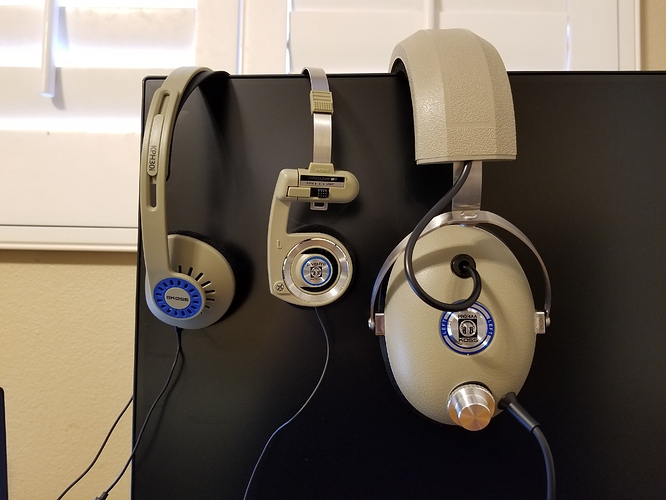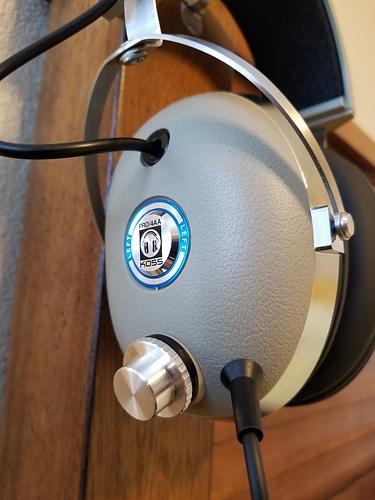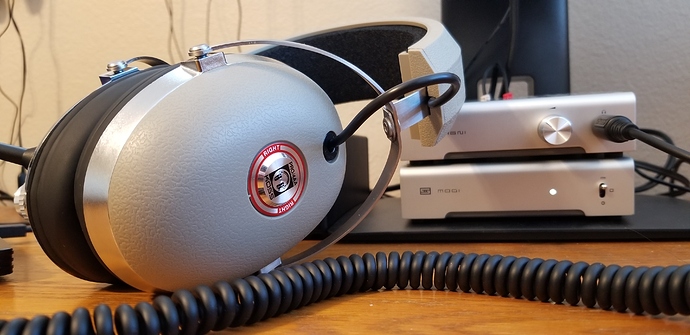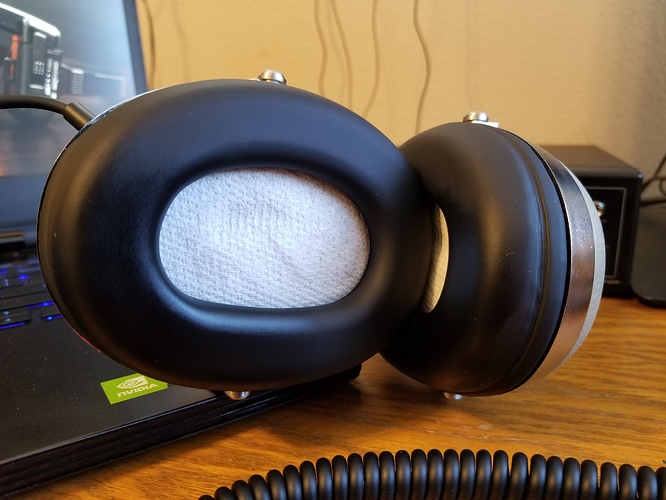I got Pro4AA as part of the Koss Retro Bundle on Black Friday. $99 for this brick, the KPH30i in beige, and the Porta Pro LE in beige. I thought I’d share my experience with them because (1) there is little information about them online – most regarding actual vintage Pro4AAs – and (2) whatever information is available is vague an inconsistent. My opinion is only a small drop in the bucket, but I hope the perspective of a young guy in his twenties not tripping on nostalgia is still worth something.
Comfort
I’m going to get this out of the way quickly. Yes, comfort sucks, and is actually the most consistent opinion I have found online on forums. You want to know how uncomfortable it is? Just watch Zeos’s review of the Pro4AA. Very accurate.
Worth special mention, the pads are not really pads but simply (good) air-tight seals: this is an on-ear headphone in disguise. Inside the pads is some thin foam with a circular cutout in the center, your only padding against the convex plastic grille in front of the driver. Glued to the foam is a thin-rope netting that will cut into your ears, as if having only thin foam wasn’t bad enough. For the first two days, I tried wearing these as is, and the fit was not uncomfortable – no, it was painful. Within 30 minutes, my neck hurt from the weight and overall poor weight distribution, my jaw cramped up from the clamping force, and my ears were red hot from being cut off of circulation.
By day three, I got used to everything except the stupid netting cutting into my ears. In fear of more pain from the netting as well as treble, I tried doing the paper-towel mod people do on Beyerdynamics headphones. Two sheets of 2 ply screwed up the sound completely, but one sheet solved my chief issue of comfort without really changing treble response too much. No more netting cutting my ears. 3 weeks later, although I will not say the Pro4AA is in any way comfortable, they are bearable for 2+ hours. I just need to remember to take a quick break every now and then to do stretches for my neck and facial muscles.
Build
Aside from weight, I do like how well built this headphone is. It is the antithesis of Koss of today – heavy, thick plastic, a good amount of metal, a solid coiled-cable with beefy strain relief. I have seen an Amazon review that does voice some reasonable concerns about QC, but at least from the outside, I do not see anything wrong with my unit. If anything, the vintage Pro4AAs that survive to today hint that the design, if not the manufacturing, is quite solid.
Sound
The main course. In a very general way, I feel the Pro4AA’s sound signature is neutral-bright, where “bright” refers to a very spiky treble region. It was a bit jarring for me to get used to at first, but I have come to like it quite a bit. When it comes to instrument timbre, the tuning is quite hit and miss; it’s not exactly the most natural sounding of headphones. Even so, I have been able to easily immerse myself in music with these. Normally when trying to judge how a headphone sounds, I would quickly skip around to key parts of certain songs I know well and compare with other headphones I have. And yet with these, I sometimes got distracted enough to let the track keep playing because it just sounded… interesting. I hate to use this phrase, but the Pro4AA has a sense of “musicality” that I don’t feel with my other headphones. Not with the KPH30i, not with the AD900x, not even with the 95X.
What does “musicality” mean? Beats me, but that’s all I can say to describe the wholistic experience I feel. The Pro4AA has many faults in sound that I will describe below, but despite these faults – heck, maybe because it’s flawed – the Pro4AA is just… very enjoyable to use.
Bass
Tonally, there is nothing all that special. It feels quite flat until it gently rolls off past ~60-80Hz. Whereas most closed-backs focus on a deep and punchy bass response that’s somewhat Harman, the Pro4AA offers no particular emphasis on bass frequencies.
But the quirks in bass is not related to quantity. The Pro4AA has really snappy bass kicks, more so than my AD900x and even 95X, which I believe have “tight” and clear bass. Rather than a “thump,” bass comes out as a “click.” Personally I find this snappiness to be very satisfying; imo “crisp” is a term more suited for treble, but for this one case, I really want to say the Pro4AA’s mid-bass is very, very “crisp.” Not a very accurate presentation, but indeed a fun one.
Despite this, there is a major weakness to the bass: resolution is poor. Worse than the KPH30i or Porta Pro. Let me explain: separation and detail retrieval are quite good in that I can easily tell apart complex bass lines. It passed the speedcore test. But actual notes feel like they are smoothened over; there is no texture to the bass. I honestly don’t know how to describe it well, but imagine an visual art piece done in black and white. The artist uses various techniques like hatching, stippling, etc. to generate texture and value, to give the illusion of depth and realism. The Pro4AA presents only the line-art of such artwork. Every major form is identifiable, but there is no information beyond very distinct silhouettes.
Mids
In frequency sweeps, it’s characteristically Koss. Very smooth and flat until it dips a tiny bit before 1kHz and begins to gently crescendo beyond that. Unlike bass frequencies, the mids have decent detail that, while not really noteworthy, is satisfactory enough to rival modern sub-$200 studio monitors. I don’t really have much to comment about the midrange because there are no glaring faults about it nor anything special such as extra forwardness. Vocals don’t have any extra presence or clarity, nor are they recessed (unless the mix is poor).
Treble
This is where things get fun. Continuing on from the gentle slope at 1kHz, the curve grows steeper and steeper until it reaches a rather uncomfortable peak at 3kHz. It quickly dips far below “flat” at 4kHz. Then it peaks slightly at 5kHz, dips a bit at 7kHz, and then very suddenly rockets to the moon at 8kHz. Fortunately, this very painful peak is very narrow, quickly dipping at 9khz. Beyond 10kHz, treble recovers and has overall good extension to my limits of hearing at ~17kHz.
Of course, all these observations are done by ear on a sine wave sweep. But if I were to graph out the response, I feel treble would be not all too different from that of the Grado SR60e or AKG K240 MKII. Although I have not personally tried either, they seem to create a divide between people that like the unusual treble response and those that find it painful/unnatural. If you hate Grados and treble in general, stay away from the Pro4AA. Well, I expect the Pro4AA loses most people at “comfort.” :^)
I’m not afraid of sibilance in the low-mid treble, but I do find the peaks make some timbres sound very unnatural. Violins just sound… fake. Flutes are very shrill and stand out too much in orchestral pieces. Trumpets sometimes have a bit too much tininess to their sound, but this is less of an issue than the previous two. Although female vocals sound very good most times, higher notes that happen to touch the 3khz peak wrongly come out very honky and shrill compared to the rest of the singing. I like listening to the Japanese singer Nanahira (ななひら) for her slightly-nasally and high-pitched voice, but her singing comes out quite weirdly a lot of times. It’s a bit of a bummer, because other denpa singers, and singers in general sound just fine despite singing at the same pitch ranges.
On the plus side, this weird treble tuning works quite well when it’s not a complete failure. Panama by Van Halen, Chameleon by Herbie Hancock, Russian songs performed by the Alexandrov Ensemble, Mint Jams by Casiopea, Beautiful Parting (아름다운 이별) by Kim Gun-mo (김건모), Revolution by Kirk Franklin, etc. all sound quite stellar through the Pro4AA. The treble gives a lot of energy and liveliness to the sound that makes the more relaxed Koss on-ears and 95X sound dull and lifeless in comparison. The M40x may have an exciting V-shaped response that accentuates bass kicks and cymbals, but even it is pretty dead to how… musical the Pro4AA is at its best.
Treble extension is near-perfect for my tastes. I often long for a little more sparkle with the 95X. I wish for much less than with the M40x. The Pro4AA offers very clean cymbals, chimes, claps, etc. It’s quite “sparkly,” “bright,” or whatever audiophiles use to describe satisfying treble extension, but never so emphasized that it’s never tizzy or distracting even in the most treble forward of songs, such as with Crystal Ribbon by Emocosine. In contrast, I find M40x treble extension too boosted. It sounds too artificial, and the roaring of cymbals and the thumping of bass drown out a lot of details in between.
Treble is, like the rest of the frequency range, not all too resolving but it is surprisingly revealing. Taking Hancock’s Chameleon as an example, the Pro4AA reveals the background noise in a way none of my other headphones can. With the 95X, M40x, or AD900x, I can hear a faint hissing-sound, but the Pro4AA reveals an additional layer that is an even fainter whining and crackling noise. Despite the addition of more and more voices as the song progresses, it’s easy to separate this noise from the other voices till the 1:10 mark. Even more impressively, it reveals that the scratching sound at around 0:14 is continuous. I used to think that small detail was an intermittent occurrence but no, with the Pro4AA I can hear it constantly in the background from 0:14-0:30 (when it gets drowned out by the addition of an electric guitar(?)).
Soundstage and Imaging
Soundstage is very narrow, but I do not find it to be “inverted” or “un-stereo” as Zeos says. For me, it’s less claustrophobic than the M40x, which I personally feel has a very “in your head” center image that makes me want to go cross-eyed. Admittedly, centered bass is quite “in my head” with the Pro4AA, but stuff like vocals do feel more “in front” than “inside” or “behind.”
Imaging is very much stereo for me. I honestly don’t why Zeos hated the Pro4AA this much sonically, but I find it quite satisfactory. Very slight center left-right panning of the singer in songs such as Korobelniki performed by the Alexandrov Ensemble or 砕月 (ココ&さつき が てんこもり’s 作業妨害Remix) sung by Koko (ココ) are very easy to discern. Although the narrow soundstage makes it quite bad for positional cues in gaming, imaging is perfectly fine with music, whether it’s EDM, jazz, classical, or pop.
There is no sense of depth to the sound as with a lot of closed backs with poor soundstage, but there is decent separation. Even in complex pieces, it is easy to track various voices. Not as much as with my 95X but better than my M40x and AD900x, which have poor separation. IMO the Koss 60 ohms have decent separation, but tend to get overwhelmed with too many voices. Not the Pro4AA. EDM of all sorts is fine. Full orchestra starts to get a bit congested, but the Pro4AA still handles it better than anything I have except the 95X, which is in a league of its own. 80-20, heck 90-10 I would rather listen to classical music of any kind on a Pro4AA than on a M40x.
Miscellaneous
This is going to be a bit more disorganized than what I wrote above. I just wanted to make note of various quirks or traits I did not earlier.
As hinted, the pads – while not good cushions – provide good isolation. Better than M40x. Better than covering my ears with my hands. Not as good as blocking my ear canals with my fingers or ear plugs. Leakage is quite good as well. They do fair much better than my M40x.
The pads are really rubbery feeling… not all too different from the texture of the cable. Even after 15 minutes, all my facial oils get smeared on it. Very easy to clean the pads, but I kind of don’t want to be reminded every time my face is quite oily.
These are not too difficult to power, but still require a good amount to sound good. With my Schiit Magni 3+, I set the knob to ~10 o’clock on low gain for my KPH30i, a little lower for my Audio Technicas. I have to spin the knob to 1:30 for my Pro4AA. For stuff with large dynamic range like full orchestra, it means switching to 2 o’clock high gain or risk clipping with low-gain at max volume. I can of course listen at ~12 o’clock, but the sound really opens up at LOUD volumes. I normally listen to other headphones at ~60-70dBspl as measured by my phone. With the Pro4AA, I’m normally pushing 70-80dBspl.
Aside from clamping too hard, I like how the Pro4AA fits with the paper towel mod. The Pro4AAA is often known to be the first D-cup Koss, but it turns out the Pro4AA’s inside of the cup is pretty D-shaped itself. As far as I can tell, it completely encapsulates by ear. The headband is surprisingly good. It’s a bit tight, but it is well padded and matches the shape of my head very well. Rather than clamping, it’s a firm “hug” that’s pretty comfortable and adds to the stability of the headphone.
Hoooo boy, the 6.35mm plug is T H I C C. I love it.
The Koss badges on the center of the cups look nice. Blue and red indicators are always a win in my book. The blue side already has a tiny bit of chipping though, and I don’t know from what. I should probably be gentler if I want the colors to last, haha.
Conclusion
I genuinely like this headphone. I do actually reach out for it and listen to things with it, which I can’t say for my AD900x anymore. I can see how something like this was well regarded monitoring headphones. It’s not going to win any awards today, but the sound holds up much better than I expected.
That said, I can’t recommend this headphone for anyone really. More than anything, people probably buy it for nostalgia. At ~$70 this is currently at on Amazon, you can get notably better headphones – headphones that are more comfortable, more portable, have detachable cables, and in general sound better. I don’t regret the buying the Retro Bundle at $99 on Black Friday, but I don’t think I would even buy a Pro4AA alone, knowing what it sounds like. It would be a better idea to buy 3-4 KSC75 if one is looking00 for value.
Pictures:



